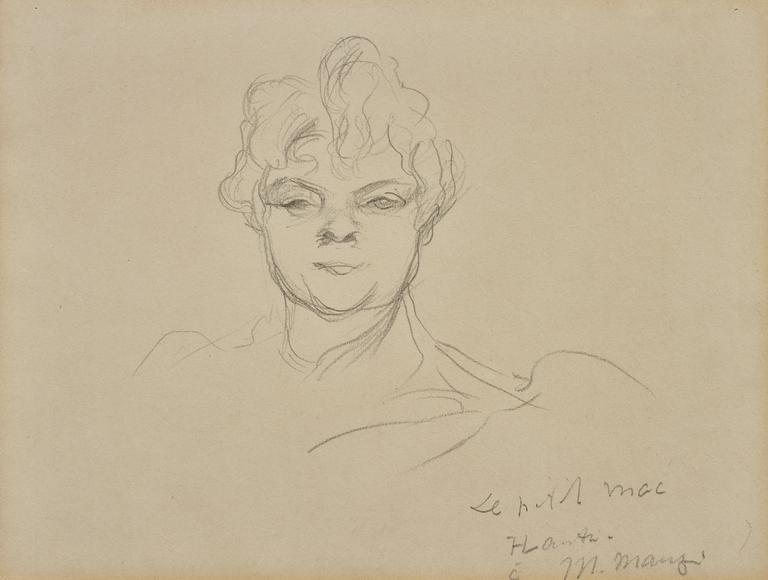
Rolande, dite le petit mac
Henri de Toulouse-Lautrec (1864 Albi - 1901 Saint-André-du-Bois)
1894
Crayon sur papier ; signé et annoté « Le petit mac / H Lautrec / à M. Manzi » en bas à droite ; 19 x 26,5 cm
Provenance :
Paris, collection Michel Manzi, (acquis auprès de l'artiste) ; Paris, galerie Manzi-Joyant et Cie ; Paris, collection Marcel Guérin ; New York, collection Sam Salz ; New York, collection Alexander & Elisabeth Lewyt ; New York, Sotheby's, 8 mai 2013 ; New York, Bonhams, 15 mai 2018 ; Paris, collection Le Polyptyque ; Albi, Musée Toulouse-Lautrec.
Exposition :
Henri de Toulouse-Lautre (Paris, Musée des Arts Décoratifs, 1931, n° 211) ; Henri de Toulouse-Lautrec, 1864-1901 (Vienne, Österreichisches Museum für Angewandte Kunst, 1966, n° 48).
Bibliographie :
Maurice Joyant, Henri de Toulouse-Lautrec 1864-1901 : dessins, estampes, affiches, vol. II, Paris, H. Floury éditeur, 1927, p. 203 ; Madeleine Grillaert Dortu, Toulouse-Lautrec et son œuvre, vol. V, New York, Collectors Editions, 1971, no. D.3.477 (reproduit).
Toulouse-Lautrec, tout autant que Degas à la génération précédente mais dans un temps beaucoup plus court, puisqu’il décède à trente-six ans, balaie les conventions artistiques et sociales. L’un et l’autre sont des peintres de l’expression, du geste, moins intéressés par le paysage que par la figure, le mouvement, et pour cela même, extraordinaires dessinateurs.
Rien ne l’illustre plus simplement, plus évidemment, que ce croquis de Rolande, dite « Le Petit Mac », une pensionnaire de la maison close de la rue des Moulins, dans le 1er arrondissement où Toulouse-Lautrec, de 1891 à 1895, avait ses habitudes et même, en 1894, résida par intermittence. Paris, à cette époque, qui fait suite à l’Exposition universelle de 1889, est la capitale du théâtre, du music-hall et de la prostitution (60 000 praticiennes environ). Lui-même, auréolé du succès de ses affiches, parvenu à la maturité de son art, mais que son handicap tient en marge de la vie sociale, y trouve une forme d’affection et l’inspiration. Le Salon de la rue des Moulins est aujourd’hui l’œuvre-phare du Musée Toulouse-Lautrec d’Albi (on y reconnait Rolande et son nez en trompette, à gauche à l’arrière-plan).
Ici la figure est extraordinairement vivante, sur le point, dirait-on, d’engager le dialogue avec la même gouaille que plus tard au cinéma, Simone Signoret dans Casque d’or. Mais la pose frontale, comme d’un buste romain, lui confère une dignité supplémentaire.
Toulouse-Lautrec donna et dédicaça ce dessin à Michel Manzi. Celui-ci, originaire de Naples comme la famille maternelle de Degas, dont il fut l’ami, était en 1894 (et restera jusqu’en 1919) l’associé de Maurice Joyant, lui-même ami d’enfance de Toulouse-Lautrec, chez Boussod-Valadon, successeurs de Goupil. C’était, avec Durand-Ruel, la plus importante galerie (mais aussi éditeur) d’art de la fin du 19ème siècle.
Il appartint ensuite à Marcel Guérin, critique d’art qui publia la correspondance de Degas et l’œuvre gravé de Gauguin ; puis à Sam Salz, l’un des plus grands marchands américains du 20ème siècle ; enfin au couple étonnant que formaient Elisabeth et Alexander Lewyt. Elle, française naturalisée américaine, défenseur de la cause animale ; lui, fils d’immigrant autrichien, inventeur en série. Leur collection comprenait des œuvres majeures de Cézanne, Modigliani, Picasso...
